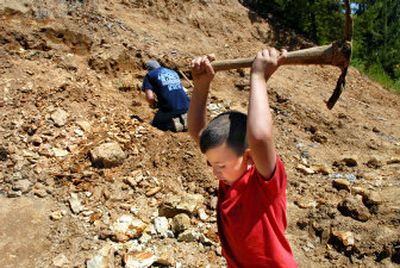Digging for garnets and fossils in ‘Gem State’

There are many reasons why Idaho is called the “Gem State,” and one of them can be washed right out of the mud at the Emerald Creek Garnet Area, seven miles into the St. Joe National Forest west of Clarkia.
Here, you can dig and sift and wash all day – or as long as your back will hold up – looking for star garnets in the rough. And, you can take them home at the end of the day.
“What’s so nice about this place is that no one leaves empty-handed,” said forest ranger Carol Ratcliffe. “There are only two major places in the world where you can still find star garnets – this place, and a place in India.”
So why is the place called Emerald Creek when it’s full of garnets? According to the Idaho Historical Society, when locals first found garnets in the area they mistakenly thought they’d hit the mother lode of emeralds, hence the confusion.
“It was in the ‘50s people really started coming here,” Ratcliffe said. “It was private land at the time and they’d just come up here willy-nilly, blowing big holes with dynamite. It was a mess.”
Ratcliffe said locals and rockhounds soon realized the area needed better management if it wasn’t going to be destroyed, so they purchased the land and donated it to the Idaho Forest Service.
Until two summers ago, garnet diggers would go into muddy Emerald Creek and dig away, but concerns about water quality led the Forest Service to create a more consumer-friendly setup.
Today, mud from the creek is hauled up in a big pile next to the sluicing area. Visitors grab buckets of mud, sift it and then haul what’s left to the sluices.
There, water circulated by a pump washes mud, silt and sediment off rocks and garnets.
A garnet in the raw has a surface like a rust-colored raisin. It’s not ruby red or purple, but blackish – it’s heavier than an average rock, and some are nicely rounded, like marbles. After a little while it gets pretty easy to spot the glassy gems in the sunlight.
“If you find a nice one, what you want to do is have it polished up at a gem shop,” said Ratcliffe. “Then you can use it in jewelry. Or you can just keep them as they are.”
The journey to the garnet site is long and winding, and the last seven miles is a gravel road. When the sign says “watch out for livestock” take it seriously – this is a free range area, full of cows.
You know you’re there when the sign reads “Rockhound information ahead.”
You can keep fossils
If you didn’t get dirty enough digging garnets, return to Highway 3 and head south for about 10 minutes, past Clarkia, which takes you to the Fossil Bowl.
This unusual combo of a huge motocross track and an internationally recognized fossil dig is uniquely Idahoan.
There’s no fancy sign – when you see the track, just pull up to the house.
“In the summer, we are usually here,” said owner Kenneth Kienbaum, who grew up there.
It was in 1972 that Kienbaum’s father, Francis L. Kienbaum, was building a snowmobile track. As he dug into the hillside, strange-looking material spilled out that was full of leaves.
“My dad didn’t know what it was,” said Kienbaum, who inherited the Fossil Bowl when his father died two years ago. “So he called the University of Idaho. They said something like, ‘Sir, it’s fall, there will be leaves on the ground’ but my dad knew this was something unusual.”
Eventually, University of Idaho paleobotanist Jack Smiley made the trip to Clarkia – a trip he never regretted.
“The professor said, ‘We knew something like this was here, but we never saw it before,’ ” Kienbaum said. “My dad and Smiley didn’t quite get along at the beginning, but once my dad realized what was here, he decided to leave the site as it was and keep it open to the public.”
Kienbaum explains that the fossils are about 15 million years old and were formed in layers of sediment at the bottom of a lake.
Take a Pulaski to the hillside and layers of clay easily come loose.
Use a butter knife to carefully separate the layers and perfectly preserved leaves, pine needles, seeds, branches and flowers come to the light of day.
“My favorite part is the colors,” said Kienbaum. “Some of the leaves are still red. Some are brown. It’s just amazing.”
The colors quickly disappear once the fossilized leaf meets air.
You’ll soon be so engrossed in digging that the dirt bikes buzzing next to the site become nothing but a faint hum.
Don’t expect to find a dinosaur.
“You can find flowers and leaves very easily,” said Kienbaum. “We find fish – but this year has not been a good one for ‘fishing.’ It’s been a while since I found one.”
School groups and researchers are frequent visitors. The latest research focuses on extracting DNA from the fossilized plant material.
Visitors get to keep as many fossils as they want.
“If someone found something very unusual, I’d ask to keep it and have it documented by one of the professors, but then I’d send it back to the finder,” said Kienbaum. “My dad wanted it to be like that. I’m following his wishes.”